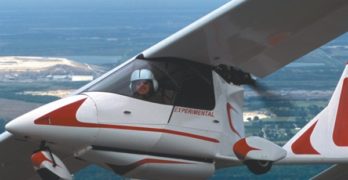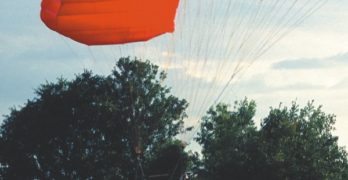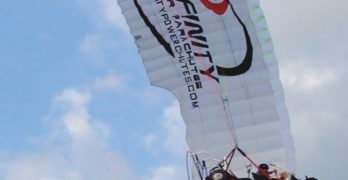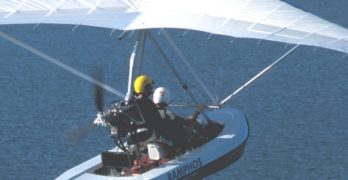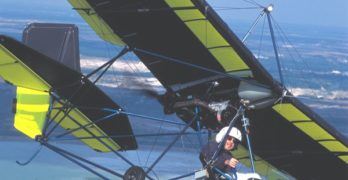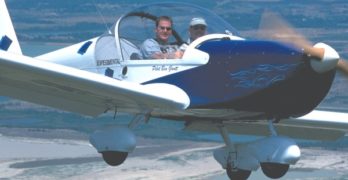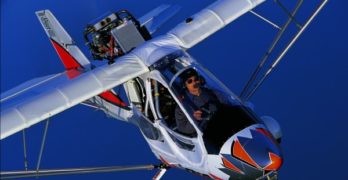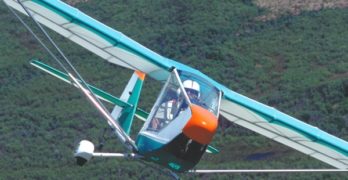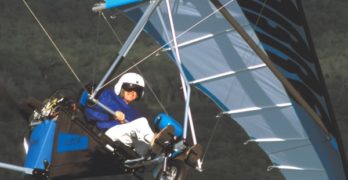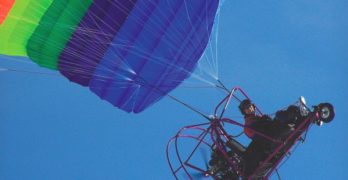Over the years, Titan Aircraft has made their Tornado a familiar aircraft seen at flight parks and airports around the nation. Since it was introduced in ’91, the sleek, efficient plane has evolved into a variety of models.
This month we examine the fine work of Roger Bacon who created a lovely red-and-white Tornado II 912, powered by the 100-hp Rotax 912S 4-stroke powerplant expected to be commonplace on light-sport aircraft. Bacon’s airplane is licensed in the Amateur-built category but its facts and figures suggest it could be flown with FAA’s proposed Sport Pilot certificate (until FAA’s new rule is introduced, a private pilot’s certificate or better is required).
Usually I prefer to fly a factory airplane to make sure it correctly represents what a buyer might receive. However, Bacon’s model is so well done, Titan Aircraft encouraged a test flight. Thanks to Bacon for his willingness to let me take his pride and joy aloft.
Search Results for : CT AND hand control
Not finding exactly what you expected? Try our advanced search option.
Select a manufacturer to go straight to all our content about that manufacturer.
Select an aircraft model to go straight to all our content about that model.
Hybrid Powered Chute
As focus sharpens on FAA’s proposed Light-Sport Aircraft regulation, the first aircraft segment to complete an ASTM airworthiness consensus standard is powered parachutes. While these aircraft are simpler, which helped speed the process, participating manufacturers got together well and hammered out their certification rules efficiently.
Summit Powered Parachutes of Canada hasn’t yet chosen to enter the Light-Sport Aircraft arena. They aren’t worried, just wary of new regulations. In fact, the company started work under England’s BCAR S regulation. Just recently, Summit was working to qualify for German DHV certification. They see no great challenge passing the proposed U.S. powered parachute standards, as currently defined.
Fortunately, the proposed Light-Sport Aircraft is not the only destination in sport aviation. It may be part of the spectrum of aviation regulations.
We’re seeing more new designs tuned to Part 103. And the Amateur-Built 51% rule will still allow many 2-seat ultralights to be built and flown as they are today.
Infinity Power Parachutes
On a warm summer evening, a large field of 3-foot-tall oats sways gently in the breeze. In this pastoral setting a runway is cut down the middle. The farmer who owns this field has a light aircraft he flies from his country property, and he’s kind enough to allow Tim Norling, a local powered parachute pilot, to use it, too. Norling operates Let’s Fly, an Infinity powered parachute dealer 20 miles north of Minneapolis, Minnesota.
By the time Norling gets his Infinity powered parachute set up, the winds have quieted down, as we hoped they might. It is a beautiful evening for flying in Minnesota, and I am ready for a flight.
Some pilots say, “Oh, those powered parachutes are too vulnerable. You can only fly them in gentle winds.” Yeah, so? Is it really imperative to fly in strong winds? Is being restricted to mild conditions a bad thing?
Powered parachutes tend only to be flown when it’s pleasant to do so.
Italy’s Ramphos Flying Boat
Making a Splash
Last year as the flying season began, an unusual flying boat appeared at airshows. The machine was called Ramphos (pronounced RAM-fohss) and it featured a form of ducted prop surrounding a pair of counter-rotating blades. While these two components commanded a lot of attention, they were de-emphasized when the 2004 season arrived.
In 2003, the presentation was market-savvy. By showing a somewhat radical version of the familiar flying boat design – we’ve seen a few of these configurations over the years – the Ramphos attracted attention in a crowded marketplace. When you’re new (to the American public), you need some way to stand out from the crowd.
However, the downside of new, potentially radical ideas is that people – like me – tend to wait until the new concepts prove themselves. So I didn’t fly the Ramphos in 2003. That changed for 2004.
Modern Machine
For the 2004 flying season, the emphasis had been taken off the counter-rotating props, though it was still displayed and remains an option.
Simple Sprint Pleasures
Excelling at “Just For Fun”
Going back to our roots and the dandy little ultralights that have given in-flight satisfaction to so many, we’re going to take a look at one of those aircraft, Quicksilver’s MX Sprint.
Some veteran pilots call the MX Sprint “humble,” but it is one of those “original” ultralight aircraft that simply won’t go away, and it shouldn’t. Why? Because the Sprint still offers a joyful flying experience that redefines boring holes in the sky. You pilot a Sprint in relative ease and at remarkable low cost, and once price enters the discussion, many ultralights show their value clearly.
Many in light-sport aviation are realizing that aircraft certified Experimental Light-Sport Aircraft (ELSA) and Special Light-Sport Aircraft (SLSAs), even when approved under a simplified, industry-created, ASTM-guided program, will be rather expensive aircraft. Some sleek fiberglass creations are reaching toward the six-figure mark – an unbelievable development given that ultralights have historically traded in a range of $8,000 to $35,000, the latter being a superbly equipped, Rotax 912-powered machine.
Star in Your Sky
The expression “seeing stars” is a good thing, if it means flying a delightful aircraft on a lovely day. After sampling the Sportstar in ’02 (see “Sportstar Pilot’s Report”, December ’02 Ultralight Flying!), I looked forward to a flight in its predecessor, the EV-97 Eurostar. You could say I had stars in my eyes. A blue Florida sky was dappled with miniature cumulus clouds, winds were mild, and the fuel tanks were full in a pretty blue-and-white Eurostar. I was ready.
On a beautiful Saturday, April 17, I flew the Evektor Eurostar with Nick Motlagh (pronounced “MOTE log”) – a sharp young aviator about to embark on a career in the air. He has been accepted to compete for fighter jet training in the Air Force after graduating from Embry Riddle Aeronautical University in Daytona Beach, Florida.
Motlagh had flown the Eurostar (N30167) over to South Lakeland Airpark to allow a flight review.
Quicksilver’s GT500 Qualifier
Quicksilver’s GT 500 is ready for sport pilots
In the automotive world, GT stands for Grand Touring and that may be an appropriate comparison for the GT 500 from Quicksilver Aircraft Manufacturing. With the unlimited view from the front seat of this tandem two-seater, touring in the GT 500 is definitely a treat.
When the sport pilot/light-sport aircraft (SP/LSA) final rule arrives on the aviation scene, this top-of-the-line model from the longtime Southern California ultralight manufacturer may well be one of the first available ready-to-fly light-sport aircraft (LSA). Quicksilver co-owner Carl von Hirsch has indicated the company will build the GT 500 as a ready-to-fly Special LSA. It will also offer the strutbraced MX Sport IIS as a LSA entry.
You might say the GT 500 is preapproved; in 1993 the tandem, two-seat aircraft received both a type and production certificate in the Primary Category (see sidebar). It’s pretty safe to say that the design will quickly pass muster under the FAA-mandated LSA consensus standards under development by ASTM International.
It’s a Winner; CGS Hawk Sport
Given Chuck Slusarczyk’s decades in recreational aviation, I imagine almost everyone in ultralight aviation has heard of the funny, Polish-speaking pioneer with the hard-to-pronounce last name (Slew-Sar-Chick). If Chuck had named his first business Slusarczyk Glider Supplies, pilots would have stumbled and renamed it for him. Knowing his name is a tongue twister, he wisely called it Chuck’s Glider Supplies.
In his early business years, when Chuck was younger and slimmer, he made hang gliders. Lots and lots of hang gliders. I flew one, as did thousands of others. He was one of a handful of east-of-the-Mississippi hang glider manufacturers. Being a long way from the West Coast where hang gliding was centered back in the ’70s, Chuck made the Californians nervous. They couldn’t keep an eye on his developments and he was regarded as unpredictable. Those who knew him thought the word should be innovative.
Then came powered hang gliding, such as it was in those days.
Sabre’s New Wildcat
Smoother and More Refined
Sabre Aircraft’s Wildcat is an evolving story of ultralight aircraft development. It also speaks to the increasing maturity of the light aviation industry.
For years, Sabre Aircraft’s sales of their various trike models may have been the largest of any U.S. manufacturer. As 2003 ended the company was reporting delivery of some 700 ultralights.
The company has long offered a good flying, simple trike with a modest price tag. Proprietor and designer Richard Helm made steady improvements to his Sabre Elite and Sabre 340 designs. But he took no major strides forward.
The vigorous pace of Sabre trike sales and the company’s need to stay on top of manufacturing issues can explain a drawn-out development period. Little time was left over for projects such as getting an entirely new trike ready for market.
That didn’t stop Helm. He kept working on elements of what would eventually become the Wildcat.
Blue Heron Marathon
Built lighter to fly better
It may be hard to believe that a company established in 1995 can be considered an old-timer in an industry, yet that’s precisely the case with Heldeberg Designs LLC and its line of Blue Heron powered parachutes (PPCs).
Nick and Marie Viscio founded Heldeberg Designs a decade ago and believe they are the second oldest, continuously operating powered parachute company in America. Only Six Chuter has a longer history under the same management and ownership.
Nick and Marie run the enterprise with help from son Nicholas D., who has a degree in mechanical and aeronautical engineering, and three part-time employees assisting with fabrication and welding. “Nick is very hands-on in operating the company,” said Mark Bayer, Heldeberg’s New York dealer with whom I flew at Sun’n Fun 2004. He added, “They’re not trying to be the biggest manufacturer, just the best.”
Why did the company choose the Blue Heron name for its machines?
- « Previous Page
- 1
- …
- 47
- 48
- 49
- 50
- 51
- …
- 61
- Next Page »


